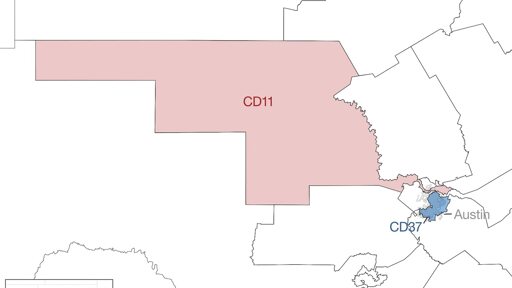As Texas Republicans try to muscle a rare mid-decade redistricting bill through the Legislature to help Republicans gain seats in Congress – at President Donald Trump’s request – residents in Austin, the state capital, could find themselves sharing a district with rural Texans more than 300 miles away.
The proposed map chops up Central Texas’ 37th Congressional District, which is currently represented by Democrat Rep. Lloyd Doggett, will be consumed by four neighboring districts, three of which Republicans now hold.
One of those portions of the Austin-area district was drawn to be part of the 11th District that Republican Rep. August Pfluger represents, which stretches into rural Ector County, about 20 miles away from the New Mexico border.



It’s a bit more complex than that—if you create districts on a purely geographic basis (like minimizing district perimeters), you usually amplify slight majorities into disproportionately large ones (e.g., a 55% demographic majority translating to a 90% legislative majority). An algorithm that tries to create districts that proportionally translate demographics to representation usually ends up with district boundaries that superficially resemble gerrymandered ones.
I think this is an important point that https://bdistricting.com/2020/ glosses over. Some of the representation “guarantees” that were part of the VRA are actually defeated by doing purely geographic districting. Oft-times there’s enough BIPOC population that’s widely distributed, but needs to be “packed” (to use the gerrymandering terminology) in order to given even a chance of proportional representation.
My state of Arkansas is a good example https://bdistricting.com/2020/AR_Congress/ BIPOC is >= 25% of the population, but to get a distract that was 50% BIPOC it would have to snake across the state in a way that would be very visually similar to a gerrymandered district.
Multi-member districts can help, but they cause a loss of representation locality.
It may be that it’s impossible to produce an algorithm that satisfies all our (collective) fairness constraints.
https://www.youtube.com/watch?v=Lq-Y7crQo44
This is a really neat video about algorithmic redistricting. It doesn’t really make any claims about the politics around drawing maps but it does a great job of showing how easily the maps can be manipulated to give set results. It’s really neat to see how the different things we can optimize for may or may not produce “fair” results.
Really worth a watch imo!